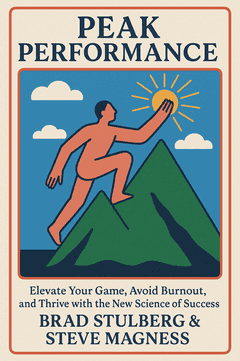What is
Stealing Fire by Steven Kotler and Jamie Wheal about?
Stealing Fire explores how non-ordinary states of consciousness (ecstasis) — marked by selflessness, timelessness, and effortlessness — drive breakthroughs in performance, creativity, and problem-solving. The book examines how Silicon Valley innovators, Navy SEALs, and scientists use techniques like flow states, psychedelics, and meditation to harness these altered states, arguing that ecstasis is revolutionizing fields from business to mental health.
Who should read
Stealing Fire?
This book is ideal for professionals seeking peak performance, psychologists studying altered states, entrepreneurs pursuing innovation, and anyone interested in biohacking or mindfulness. It’s particularly relevant for leaders aiming to foster group flow in teams or individuals curious about the science behind practices like meditation and psychedelic therapy.
Is
Stealing Fire worth reading?
Yes, Stealing Fire offers a provocative blend of neuroscience, anthropology, and case studies to challenge conventional views on productivity. Its insights into flow states and ecstasis provide actionable frameworks for personal and professional growth, though readers should critically evaluate its controversial advocacy of psychedelics and niche practices.
What are the key concepts in
Stealing Fire?
- Ecstasis: Altered states characterized by heightened focus and creativity.
- STER Framework: A model (Selflessness, Timelessness, Effortlessness, Richness) to achieve ecstasis.
- Flow States: Peak performance phases where individuals operate at maximum capability.
- Group Flow: Collaborative ecstasis used by teams like Navy SEALs to solve complex problems.
How does
Stealing Fire relate to Steven Kotler’s previous book
The Rise of Superman?
While The Rise of Superman focuses on individual flow states in extreme athletes, Stealing Fire expands this concept to group dynamics and diverse methods of achieving ecstasis, including psychedelics and technology. Both books emphasize unlocking human potential through altered consciousness but target different audiences and applications.
What is the STER framework in
Stealing Fire?
The STER framework outlines four traits of ecstasis:
- Selflessness (loss of ego)
- Timelessness (distorted time perception)
- Effortlessness (intrinsic motivation)
- Richness (heightened sensory input)
These states enable breakthroughs by quieting the brain’s default mode network, fostering creativity and problem-solving.
What role do psychedelics play in
Stealing Fire?
The book discusses psychedelics like LSD and psilocybin as tools to induce ecstasis, citing research on their potential to treat mental health issues, boost creativity, and dismantle ego barriers. Kotler and Wheal advocate for structured, responsible use while acknowledging legal and ethical challenges.
How does
Stealing Fire address meditation and mindfulness?
Meditation is framed as a reliable method to achieve ecstasis, enhancing neuroplasticity, emotional regulation, and focus. The authors highlight practices like transcendental meditation and Zen, showing how they cultivate "timeless" states that drive innovation and reduce stress in high-pressure environments.
What criticisms exist about
Stealing Fire?
Critics argue the book overstates the accessibility of ecstasis for average readers and downplays risks associated with psychedelics. Some find its reliance on niche examples (e.g., Burning Man, SEAL Team Six) less applicable to everyday life, though its core concepts remain widely debated in performance circles.
How is the Prometheus myth used in
Stealing Fire?
The Greek myth of Prometheus stealing fire symbolizes humanity’s quest to harness altered states for progress. Kotler and Wheal liken modern seekers (scientists, entrepreneurs) to Prometheus, framing ecstasis as a transformative “fire” that unlocks hidden potential and societal advancement.
Why is
Stealing Fire relevant in 2025?
With growing interest in mental health biohacking, workplace burnout solutions, and psychedelic research, Stealing Fire’s exploration of sustainable ecstasis aligns with trends in productivity science and holistic well-being. Its frameworks remain influential in corporate training and personal development programs.
How does
Stealing Fire suggest applying ecstasis to daily life?
The book recommends practices like mindfulness, breathwork, and controlled exposure to novel experiences (e.g., adventure sports). For organizations, it emphasizes creating environments that trigger group flow through psychological safety, clear goals, and spontaneous collaboration.














